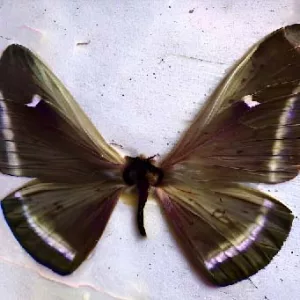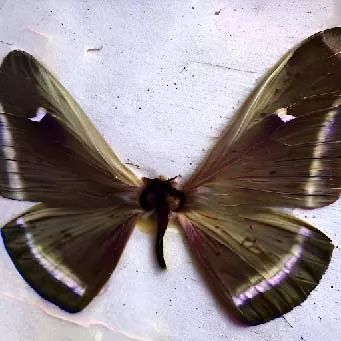Bats and Moths
According to an article published in Bioscience, At least 300 million years before bats appeared in the Eocene, around 50 million years ago, insects occupied all terrestrial habitats. Bats are the ultimate enemies of insects, especially moths. Using the power of ultrasound, bats use echolocation to find food by emitting high-pitched calls into the air and listening to the echoes that return to them. But some moths are warriors! For example, the wings of the cabbage tree emperor moth (Bunaea alcinoe) are covered in microscopic scales that absorb sound waves emitted by bats in pursuit of prey.

Biomechanism explained
Assistant Professor and Curator of the Florida Museum of Natural History‘s McGuire Center for Lepidoptera and Biodiversity, Akito Kawahara, focuses on butterfly and moth diversity and evolution. The order Lepidoptera includes both butterflies and moths. Dr. Kawahara has devoted a great deal of time and energy to studying the mechanisms that moths have developed to protect themselves from being eaten by bats. Since moths have received relatively little attention from scientists, their study piqued his interest. This is in part because night-flying insects and mammals, like bats and moths, are notoriously hard to study. In order to avoid becoming someone’s midnight snack, moths have developed some fascinating defense mechanisms. Dr. Kawahara’s lab rears moths in captivity to study these mechanisms and also collects moths from the wild by placing a white sheet under ultraviolet light at night. Dr. Kawahara’s team has observed a number of defensive mechanisms in moths. They are the Creation of the Ear, the Generation of Ultrasound, Audio emulation, and Colliding with Tails. Besides some porous structures found in moths’ wings are very helpful for this stealthy behavior!

Sound absorbing techniques
According to Marc Holderied, a bioacoustics at the University of Bristol in England and research co-author, “They have this stealth coating on their body surfaces which absorbs the sound.” “We now comprehend the underlying mechanism.” The researchers discovered that while these moths lack ears that could warn them of an oncoming predator, they have instead evolved scales that are the right size, shape, and thickness to absorb the ultrasonic sound frequencies employed by bats.
The scientists watched how it converted sound wave energy into movement by firing ultrasonic sound waves at a single, minuscule scale. The process was then recreated by the scientists using a 3-D computer model, which revealed that the scale could absorb up to 50% of the energy from sound waves. Below is a YouTube link on how moths create an ultrasound to deceive bats.
Watch The Following Video On YouTube:
Furthermore, such earless moths don’t merely avoid bats by using their wings. The same researchers published online on October 18 in the Journal of the Acoustical Society of America that more moths in the same family as B. alcinoe also exhibit sound-absorbing fur.
Holderied and his colleagues discovered that the fluffy thoraxes of the Promethea silk moth and the Madagascan bullseye moth also absorb sound waves via a distinct mechanism known as porous absorption. The furry-bellied moths absorbed up to 85% of the sound waves that they experienced in lab experiments. The equally fluffy cabbage tree emperor moth may also possess this talent, according to researchers.
Future scope
Other moths with ears may detect approaching bats and immediately veer away from their predators by dodging and plunging in perilous directions. Researchers believe that some moths’ long tails on their wings may be able to be twisted in order to interfere with bats’ sound waves. To combat predators, still more moths create toxins.
According to Akito Kawahara, an evolutionary scientist at the Florida Museum of Natural History in Gainesville who was not involved with the study, having sound-absorbing fur and scales “may need a lot less energy in terms of defense from the moth’s side.” It is a particularly distinctive form of passive defense. Holderied and his associates plan to next investigate how various scales that are fastened together react to ultrasonic sound waves. The information might one day be used to improve soundproofing technology for acousticians and sound engineers.
